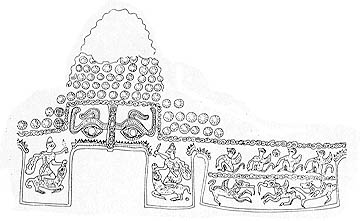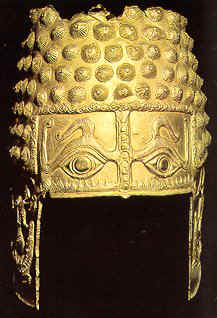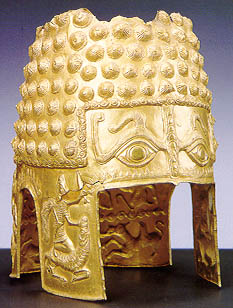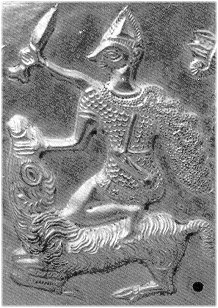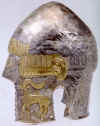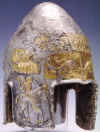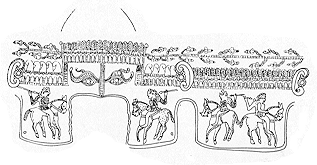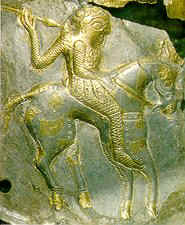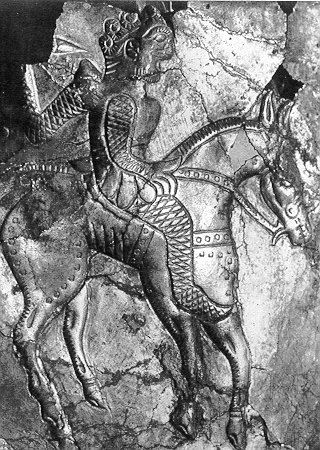Helmets
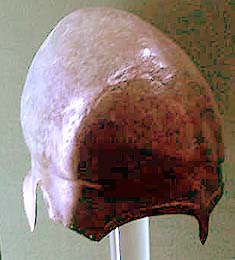 Left:
a Chalcidian helmet on display in the Vratsa museum (north-western Bulgaria).
As photography is not allowed in any Bulgarian museum, this photograph had to
be taken in bad light without a flash, and the colours are somewhat different from
the original.
Left:
a Chalcidian helmet on display in the Vratsa museum (north-western Bulgaria).
As photography is not allowed in any Bulgarian museum, this photograph had to
be taken in bad light without a flash, and the colours are somewhat different from
the original.
Introduction
Add figures 16 (p61) and 26 (p 67) from Ancient Gold Wealth of the Thracians
Most Thracian troops did not wear helmets, although this practice became more common later on. The most common helmet in use in Thrace was the Chalcidian helmet. When exactly the Thracian peltast adopted the helmet which ultimately became known as the 'Thracian' is difficult to establish, but this had without doubt appeared by the middle of the 5th Century B.C. They probably came into general use rather later, and certainly the vase paintings generally show Thracians as wearing the 'alopekis' in one of its varieties. To begin with, only Thracian noble cavalry wore helmets, and not even all of them, either. There was a marked difference between helmets from northern and southern Thrace, with the northern helmets showing Skythian influence, while southern helmets were mainly Greek or Thracian styles. Helmet styles continued in use in Thrace after they had gone out of fashion elsewhwere, and newer versions took some time in being taken up by Thracian troops.
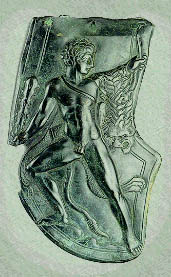 �Right: Part of a helmet, bronze, village of Gurlo, Pernik district,
5th Century BC. It bears a relief figure of the young Heracles. He holds a
cudgel in his right hand. A lion hide hangs on his left arm,in which he holds
the bow. A goritus (quiver) is fixed on his back by a strap across his shoulder
�Right: Part of a helmet, bronze, village of Gurlo, Pernik district,
5th Century BC. It bears a relief figure of the young Heracles. He holds a
cudgel in his right hand. A lion hide hangs on his left arm,in which he holds
the bow. A goritus (quiver) is fixed on his back by a strap across his shoulder
(The following text is from Duncan Head's Slingshot article:)
Most helmets were bronze; but at least one fifth or fourth century grave held the remains of an iron helmet, unfortunately too decayed for reconstruction, while another contained a leather helmet of which all that remained were bronze cheek and neck guards, and elaborate appliques decorated with palmettes and spirals. The commonest type of helmet would probably have been that which the Greeks adopted from the second quarter of the fifth century, and which we usually mean when speaking of "Thracian" helmets. It was distinguished by a peak to shade and protect the eyes, a short neck guard, and long cheek-pieces shaped to fit the face, pointed at the chin, and sometimes decorated with a stylised beard and moustache in relief. The skull shape varied enormously; sometimes it was low and rounded, sometimes conical, but the most spectacular and distinctive was the type shown in Figure 20, with a high, forward sweeping skull presumably inspired by the shape of the traditional cap. Such helmets when used in Greece and Macedon were often crested and sometimes had extra crests or feathers as side-ornaments, but the actual Thracian examples I have seen seem to have no trace of fittings for a crest. The Kazanluk paintings show such helmets worn by all the cavalry.
Hybrids and variants also occur; it is difficult to know whether to call the example in Figure 21 Thracian or Boeotian, since it combines the skull of the former type with the distinctive downswept brim of the latter. Whether it had cheek-pieces or not I do not know. Figure 22 would probably have been the most impressive of the lot. It has tall bronze horns and clearly originally had a horsehair crest of Greek style, for which the fitting remains. Cheek pieces were of iron, according to the catalogue of the exhibition in which the helmet appeared, though the rest of it is bronze; presumably fragments remained to enable this conclusion to be reached. A Thracian officer in this headgear would be a spectacular subject for a figure manufacturer (he hints none too subtly).
Early Helmets
 The
most common helmet found in Thracian sites is the Chalcidian helmet
(Archibald, pp 201-202). Of the known forms of Chalcidian helmet,
only the primitive version appears prior to the second half of the fourth
century. This has a slight ridge separating the skull and sides, the
neckguard recessed inwards; a curved opening for the ears; deep, rounded
cheekpieces hammered out from the sides and a short nosepiece, frequently
accentuated with a pair of stylized brows in low relief. A more advanced
late fifth-century version from Rouets has a relatively high crown, longer,
sickle-shaped cheekpieces, and long, pronounced eyebrows meeting in a curved
V-shape across the front. Two bands of engraved ornament, tongues and
guilloche, separate the skull from the sides. The neckguard is straight,
with a slightly upturned lower edge. Hinged cheek-pieces appeared in the
fourth century.
The
most common helmet found in Thracian sites is the Chalcidian helmet
(Archibald, pp 201-202). Of the known forms of Chalcidian helmet,
only the primitive version appears prior to the second half of the fourth
century. This has a slight ridge separating the skull and sides, the
neckguard recessed inwards; a curved opening for the ears; deep, rounded
cheekpieces hammered out from the sides and a short nosepiece, frequently
accentuated with a pair of stylized brows in low relief. A more advanced
late fifth-century version from Rouets has a relatively high crown, longer,
sickle-shaped cheekpieces, and long, pronounced eyebrows meeting in a curved
V-shape across the front. Two bands of engraved ornament, tongues and
guilloche, separate the skull from the sides. The neckguard is straight,
with a slightly upturned lower edge. Hinged cheek-pieces appeared in the
fourth century.
A few magnificent examples of Corinthian helmets have been found in Thrace, and a reconstruction of a Thracian noble wearing one of these helmets is shown at left. This early fifth century helmet has flattened sides, long cheek-pieces covering the whole face as far as the nosepiece, and a pronounced relief line encircling the eyes.
A warrior buried in Golyamata Mogila, Duvanli (in central Thrace), was equipped with a leather helmet strengthened with a bronze neckguard, visor, and cheekpieces decorated in low-relief patterns including volutes. These recall the elaborate versions of the 'Thracian' helmet form depicted on mid-fifth century Attic Red Figure Vases.
|
|
|
|
^^(Fig 12): Front view of a Bronze helmet from an unknown site in Bulgaria, second half of the 5th century BC. "Thracian Treasures.... " pl. 188. The photograph below is from Alexander Fol, Thrace and the Thracians - click to see a larger picture. Height 21cm. National Archaeological Museum Inv. No. 4013. The griffin is on both sides. I have reconstructed this helmet (combining the two helmets together) to make the picture at top right. Height 21cm. Click to see a larger and different view from Gold der Thraker (No. 187). |
^^(Fig 13): Chalcidian Helmet from near Nova Zagora, Bulgaria, 5th century BC. Nova Zagora Museum of History, Inv. No. 1152. Eyebrows are indicated, with a small tongue between them. Hinged cheek-pieces on both sides. "Thracian Treasures..." Pl. 187 |
|
Left: A bronze helmet from Domlyan. Problemi na Izkystvoto 1997 3/4 p40 |
|
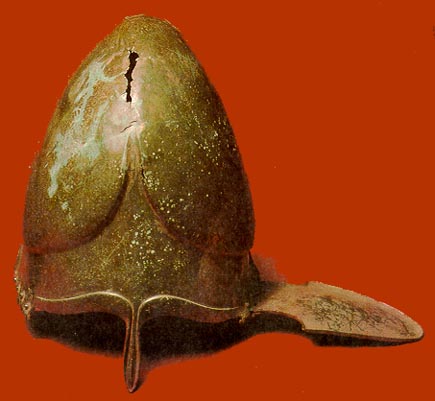
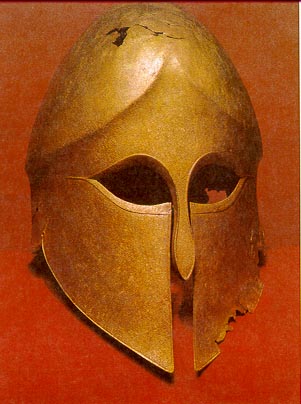
 Above Left:
bronze Attic helmet from Bulgaria Above right and below left: Bronze
sixth century Corinthian helmet from Chelopechene in the Sofia district. It is
20.9 cm. in height. Now in the Metropolitan Museum of Art. Both pictures are from Alexaner Fol,
Thrace and the Thracians.
Above Left:
bronze Attic helmet from Bulgaria Above right and below left: Bronze
sixth century Corinthian helmet from Chelopechene in the Sofia district. It is
20.9 cm. in height. Now in the Metropolitan Museum of Art. Both pictures are from Alexaner Fol,
Thrace and the Thracians.
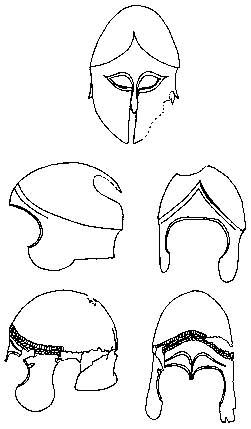
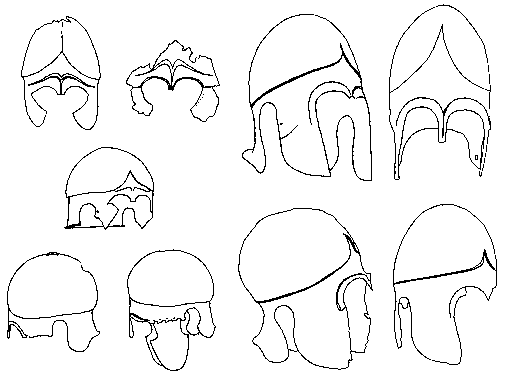
Drawings of Corinthian and Chalcidian helmets found in Thrace from Archibald p 201 (left) and p 252 (right). The middle group show Chalcidian helmets of the older form. The bottom helmet from the first group is from Rouets. The right-hand group shows Chalcidian helmets of the mid-4th-century BC type. The helmet in the extreme top -right hand corner was found with a rhomphaia at Symbola in Bulgaria.
http://mail.humanities.ccny.cuny.edu/www/history/reader/thracianhelmut.htm - colour photo of a Thracian Corinthian helmet
Later Helmets
The following text is closely based on pp 252-254 of Zosia Archibald's The Odrysian Kingdom of Thrace.
In the fourth century, both Thracian light cavalry and peltasts began to wear helmets. A variety of styles was worn. The older type of Chalkidian helmet found in fifth-century tombs with engraved, stylized eyebrows continued to be used well into the fourth century. The more advanced type has two variants, with fixed or hinged cheekpieces.
In the fixed form, the neckguard, shaped to fit the back of the neck, extends towards the shoulders, while the broad cheekpieces have vertical sides toward the cheeks, curving up at the back and over the ears. The brows are lightly profiled and there is a vestigal nosepiece. The crown is raked back sharply from the sides. Many helmets found in Thrace show signs of repeated wear and tear, with riveted inserts and tenons.
The helmets with hinged cheekpieces have a high, well-rounded crown from front to back. A gentle curve separates the skull form the straight neckguard,shaped at the lower edge. The tongue-shaped cheekpieces are longer.
Elaborate parade helmets of Greek type continued to be worn in central Thrace. Parts of a sheet gold composite version were found at Panagyurishte. The older-style Chalcidian helmets were worn by native Thracian troops, until the 'Phrygian' helmets arrived in Thrace with the invading Greek and Macedonian forces. Helmets with hinged cheekpieces might have belonged to Thracian commanding officers.
Cap- or hat-like helmets were widespread in the fourth century and early Hellenistic period. They were made of mostly made from bronze, but a Phrygian style helmet found at Pletena, in the Rhodopes mountains of Bulgaria was made of iron with a sheet of bronze to cover the lower face, moulded to imitate beard locks and a moustache. This helmet was found with a rhomphaia.
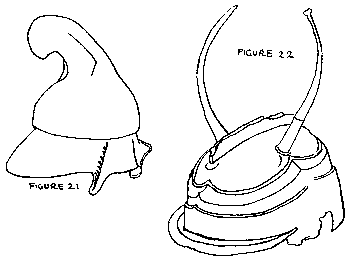
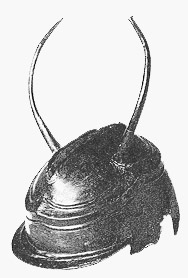
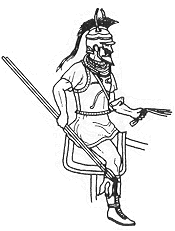 Figure 21: Helmet from Moldavia combining
Thracian and Boeotian features (Best)
Figure 21: Helmet from Moldavia combining
Thracian and Boeotian features (Best)
Figure 22: Horned helmet, bronze, but apparently originally possessing iron
cheek-pieces, 4th century, (Thracian Treasures no. 246) Archaeological Museum
Inv. No. 3454, Bryastovets (Karagach), Bourgas district. Height
23.7cm. This photo is from the 1976 British Museum exhibition; click to
see a larger view from the 1980 German exhibition (Gold der Thraker
No. 242)
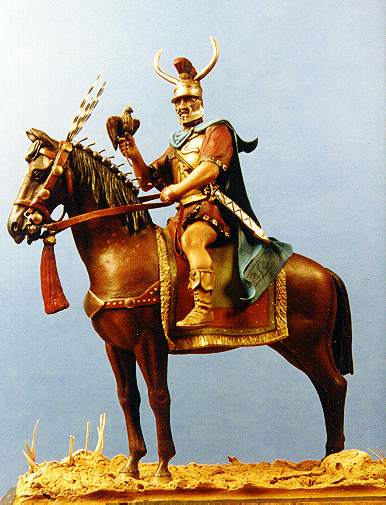
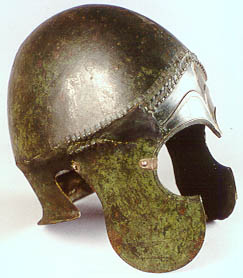

Left: A model of a Thracian noble wearing the horned helmet (though a bit
exaggerated!) above; an image sent by Daniella Carlsson.
Right: a Chalcidian (or Attic?) helmet from the National Archaeological Museum,
Sofia, and a helmet fragment with the royal double-axe symbol carved on it..
 Figure
20: Two views of a Thracian helmet, bronze, 4th century. after my own sketches
of no. 247 in the British Museum Thracian Treasures exhibition of 1976
Figure
20: Two views of a Thracian helmet, bronze, 4th century. after my own sketches
of no. 247 in the British Museum Thracian Treasures exhibition of 1976
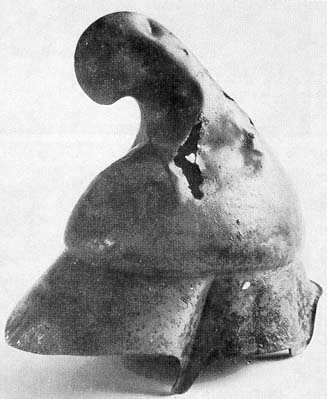 Thracian helmet from
Moldavia, plate 6 from JGP Best, Thracian Peltasts and their Influence on
Greek Warfare. (Moldavian Museum of History and Regional Geography)
Thracian helmet from
Moldavia, plate 6 from JGP Best, Thracian Peltasts and their Influence on
Greek Warfare. (Moldavian Museum of History and Regional Geography)
 Left: bronze
Thracian Helmet, plate 101 (page107) from Hoddinott, found in
Kovachevitsa, east of the upper Nestos valley. Height overall 39cm,
helmet only 23.7cm. "The form follows the style of Thracian headgear,
perhaps a legacy of the Otomani flame symbol."
Left: bronze
Thracian Helmet, plate 101 (page107) from Hoddinott, found in
Kovachevitsa, east of the upper Nestos valley. Height overall 39cm,
helmet only 23.7cm. "The form follows the style of Thracian headgear,
perhaps a legacy of the Otomani flame symbol."

Above: Thracian helmet from the Kazanluk plain - the 'Sashova mogila' Tomb, late 2nd c. B.C. The helmet is somewhat earlier- of 3rd c. BC, possibly.
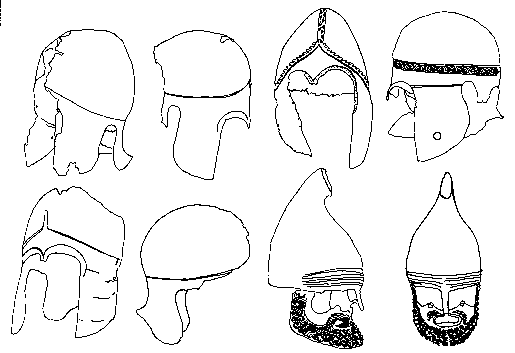
Above: Drawings from p 253 Zosia Archibald's "The Odryisan Kingdom of Thrace". Left: Chalcidian helmets from Yukelnik, Rousse. Right: Chalcidian helmets from Yudelnik (top), and pilos-type helmet from Pletena, central Rhodopes.
Two views of a Thracian and a Chacidian helmet in the National History Museum, Sofia. The Thracian helmet was discovered in1997 in Pletena, western Rhodope mountains. Silver band appliques are attached to the eyebrows and on the under-brows.It is dated to the first half of 4th Century BC. Thracian helmets were worn over felt or leather caps. This is suggested by the remains of felt on the inner side of this helmet (on the callot) and by the remains of leather on other helmets. 21 "Thracian" helmets have been found inside the territory of Ancient Thrace.
Late 4th century shield, Chalcidian helmet, and greaves found in the Dolna Koznitza mound near Kyustendil in 1989 (south-western Bulgaria). It has a short inscription on it. It is on display at theKyustendil Museum.
http://www.mts.net/~mkrieger/thracek.htm
- painting of a Thracian helmet
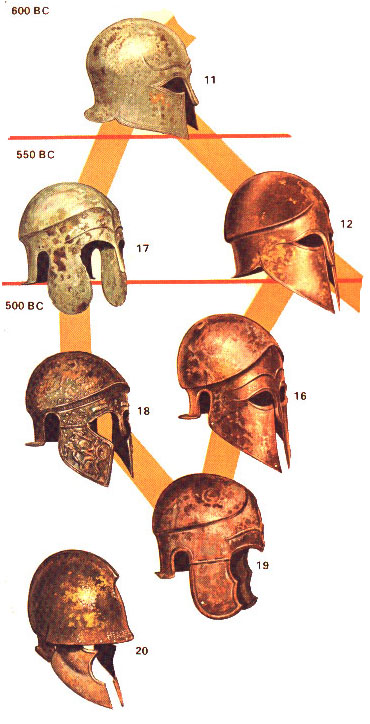 Left:
Greek helmets of the types found in Thrace, shown in chronological order, from
Peter Connolly's Greece and Rome at War. The Chalcidian type is on the
left, and the Corinthian type on the right, becoming the Attic and Thracian
types at the bottom.
Left:
Greek helmets of the types found in Thrace, shown in chronological order, from
Peter Connolly's Greece and Rome at War. The Chalcidian type is on the
left, and the Corinthian type on the right, becoming the Attic and Thracian
types at the bottom.
Above: Corinthian and Chalcidian helmets from Warry.
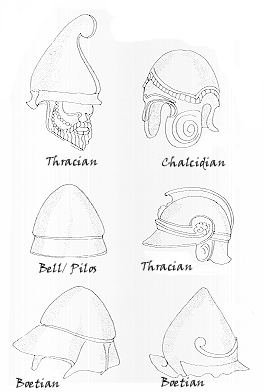 Left: helmet styles from Jack
Cassin-Scott, Costumes and Settings for Historical Plays, Volume 1: The
Classical Period, 1979, p 65.
Left: helmet styles from Jack
Cassin-Scott, Costumes and Settings for Historical Plays, Volume 1: The
Classical Period, 1979, p 65.
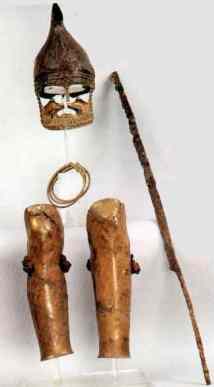 Left:
Blagoevgrads region: bronze helmet, bronze greaves, three bronze torques,
and an iron rhomphaia (all found together): end of the 4th, beginning of the
3rd century BC. Items 35, 40, 39, and 41 from the Helsinki
exhibition.
Left:
Blagoevgrads region: bronze helmet, bronze greaves, three bronze torques,
and an iron rhomphaia (all found together): end of the 4th, beginning of the
3rd century BC. Items 35, 40, 39, and 41 from the Helsinki
exhibition.
Above: 4th century bronze Items 36 and 37 from the Helsinki exhibition. The Chalcidian helmet at left is from a mound burial near Dolna Koznitsa, Kjustendil Region. The Thracian helmet at right is from Shipka mound No. 81.
The Chalcidian type has a cone-like callot (calotte), curved part with rounded ends over the back of the head and sickle-like cheek pieces. A pediment is shaped above the forehead by a relief fold. A plastically worked out rim follows the oval of the eyes, and the arcs above the eyebrows are joined in a short, pointed, nose-piece.
The Thracian helmet has a conical calotte with rounded walls. It passes upwards into a forwards tapering top. The calotte narrows near the base, and after a low cylindrical band, broadens horizontally thus forming a visor in front. It is separated by the recesesses for the ear from the part that protects the back of the head. There are traces of soldered palmetto-like appliques on both sides of the top. There are also traces of soldered horizontal ornament in front, at the base. The predominant part of helmets of this type were found in Thrace.

Above: Late Macedonian style equipment as shown on the Pergamon monument in the Pergamon Museum in Berlin (Author's photograph). Note the helmet.
Helmets from Northern Thrace

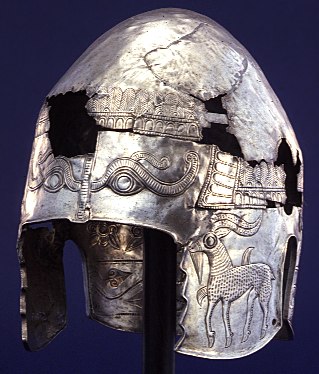
North
Thracian Silver Helmet, ca. 400 B.C.; ; height 24 cm (9 1/2 in.), Detroit
Institute of the Arts
(Text from the DIA web site): The richly ornamented helmet was fashioned
for a wealthy member of a northern Thracian tribe living near the Danube river
in modern Romania or Bulgaria. It was hammered from one sheet of silver with a
high dome to accommodate the top-knot of hair worn by many Thracians.
The main elements of the design are in low relief; the details were chased
and engraved. On the brow piece fierce eyes with bushy eyebrows stare out. One
cheekpiece bears a horned animal, the other a huge bird of prey with a fish in
its beak and a rabbit in its claws. The back and upper edges are embellished
with linear designs of rosettes, vines, feathers and scallops. The
interpretation of the imagery is uncertain, but the motifs may refer to
traditional myths well known to contemporary Thracians and appropriate to the
elaborate armor of a warrior.
North Thracian helmets followed Skythian practice, with some very interesting gold and silver models being moulded with multiple bumps on the top. These are thought to represent the hair-style of the wearer. The Aghighiol greave was found in con junction with a similarly decorated silver-gilt helmet, (F ig. 17B) roughly conical with rectangular cheek-pieces and a short neck-guard; it has eyes and eyebrows embossed and gilded above the wearer's eyes. An almost identical helmet comes from the Iron Gates area, and a gold helmet from Cotofenesti (Fig. 18), embossed with curls to represent hair, is obviously also related. All are from Getic noble graves, but are considered to show heavy Scythian influence in their decoration. As with the greaves, they are obviously parade items, being made of such soft metal, but it is possible that less ornate items of the same general pattern may have been worn in action.
The same Thracian silver helmet at the Detroit Institute of Arts
|
|
|
|
|
|
|
|
Gold helmet from Cotofenesti, alt. 25.5cm. Item 199 from I Daci, with drawings from that book, Duncan Head, and Vladimir Dumitrescu & Alexandru Vulpe, Dacia Before Dromichaites, Bucharest, 1988 |
.
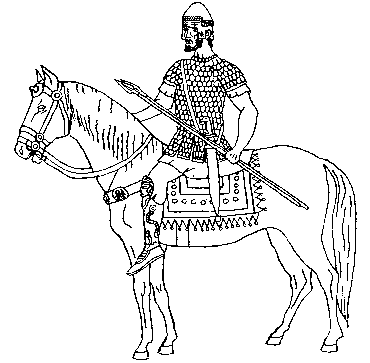 Figure
19: Possible appearance of a Thracian heavy cavairyman, late 5th or 4th century
plus the Aghighiol greave and helmet, and the saddlecloth taken from the Kazanluk
paintings.
Figure
19: Possible appearance of a Thracian heavy cavairyman, late 5th or 4th century
plus the Aghighiol greave and helmet, and the saddlecloth taken from the Kazanluk
paintings.
 �Plate B from the Osprey book
"The Skythians" shows a dead Thracian noble (B3), wearing scale
bronze armour and typical Thracian helmet.
�Plate B from the Osprey book
"The Skythians" shows a dead Thracian noble (B3), wearing scale
bronze armour and typical Thracian helmet.
Text for Skythian images from The
Skythians 700-300 BC by Dr E V Cernenko & Angus McBride, Osprey
Men-at-Arms Series, London, 1986
B3: Thracian Warrior, 4th Century BC
The costume is reconstructed from Greek vase-paintings
and from Thracian metalwork objects; the weapons are from achaelogical finds,
and include the kopis or machaira sword, typical of this region
and period. Note fox-fur cap, long ornamental cloak, and boots trimmed with
goat's hair.
Below: helmets from Rumania, from the 1997 Italian exhibition catalogue I Daci.
Left: bronze Chalcidian helmet, alt. 25.8cm, from Facau, MNIR inv 32479. Middle: bronze Illyrian helmet from Gostavatu, 20.4cm, Inv No 121. Items 200, 98, and 199 from I Daci

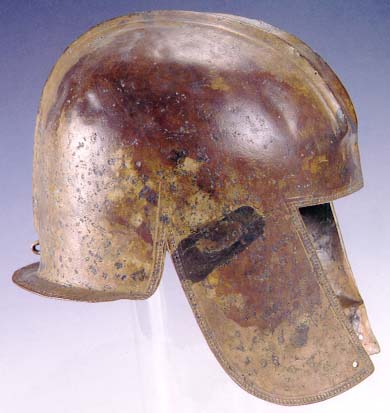
Above: Peretu silver-gilt helmet, 4th century BC, alt. 26.5 cm, MINR Inv No 73 865, Item 177 from I Daci
Above: Agighiol silver gilt helmet, 5th century BC, "alt. 8cm" , MNIR inv. Nos 11181 Item 150 from I Daci
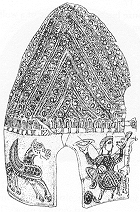
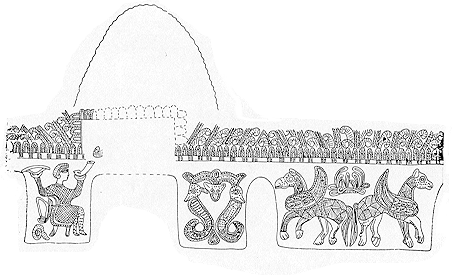
Above: drawing of a gold helmet from Baicheni, Romania, Fig. 16 from "Ancient Gold..." and Vladimir Dumitrescu & Alexandru Vulpe, Dacia Before Dromichaites, Bucharest, 1988, figure 33

Above: Iron and bronze Celtic helmet from Ciumesti, MNIR inv 69676, Item 105 from I Daci
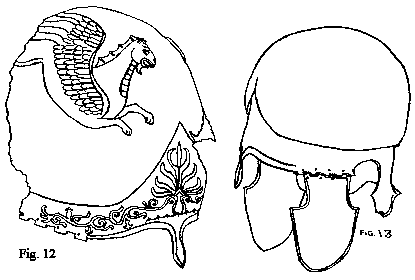
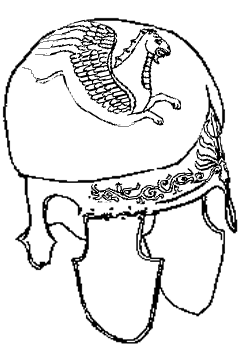


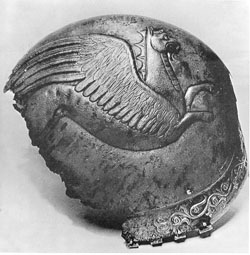






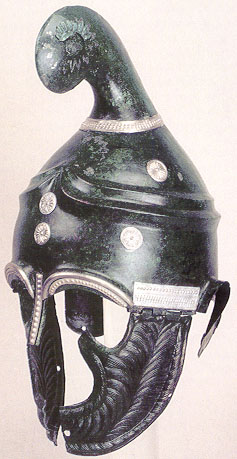
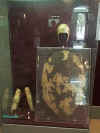

.jpg)
 Gold helmet from the tomb of a Getic prince
at Cotofenesti, in Wallachia, 4th century (Berciu). The bumps on the
helmet are thought to represent the wearer's hairstyle. "Thracian
Treasures...." 187
Gold helmet from the tomb of a Getic prince
at Cotofenesti, in Wallachia, 4th century (Berciu). The bumps on the
helmet are thought to represent the wearer's hairstyle. "Thracian
Treasures...." 187